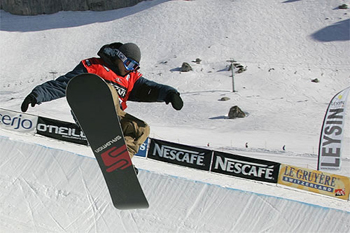
Snowboarders are vulnerable to gravity. Image: Picswiss.ch.
How do you test the effects of gravity? One way is to tip yourself over the edge of your snowboard as you are elegantly gliding along to see how long it takes until you hit the ground. We tried that last week, but it didn't work (the Plus scientist contracted concussion). Another is to win a £4.2 million grant to develop sensitive equipment to detect elusive gravitational waves. This is what the University of Glasgow has just done, having applied for the funding from the Science & Technology Funding Council.
The Glasgow experiment will significantly extend our own using the snowboard. Had it been successful, our experiment would probably have confirmed Newton's universal law of gravitation, which says that the gravitational force between two point masses is $$F = G \frac{m_1 m_2}{r^2},$$ where $m_1$ and $m_2$ are the two bodies' respective masses, $r$ is the distance between them and $G$ is the \emph{gravitational constant}, approximately equal to $6.67×10^{−11} N(m/kg)^2$. From this you can work out how long it should take a falling snowboarder to meet the snow face-on. The Glasgow experiment, however, will test a more sophisticated theory.
Newton came up with his law in 1687 and it remained unchallenged until 1905, when Einstein published his special theory of relativity. The theory says that there is a universal speed limit in the Universe: nothing can travel faster than light, that is, nothing can travel faster than roughly 300,000 metres per second. According to Newton, however, the effect of gravity is instantaneous. Take away the Sun, and the effect will be felt on Earth immediately. Einstein himself later remedied this problem by proposing that gravity isn't a force that wafts across the ether in some mysterious way, but a result of the curvature of space. An analogy that is often given is that of a bowling ball sitting on a trampoline. The ball creates a dip in the trampoline, curving its surface, so a marble placed nearby will roll into the dip towards the ball. According to Einstein, massive bodies warp space in a similar way, causing less massive bodies to be attracted to them.
One of the consequences of Einstein's theory of gravity is that when gravitational monsters such as black holes shunt their weight around, they should create ripples that can be felt across space and time. "Near black holes the curvature of spacetime is extremely high," explains Bangalore Sathyaprakash, a gravity expert. "Now imagine two black holes moving around each other: the curvature is large but also changing. It's a bit like taking a stick and moving it around in a pond. That's going to generate ripples in the water. Only in the case of black holes, we're talking about ripples in the very fabric of spacetime." These ripples are the gravitational waves researchers at the University of Glasgow will be looking for. They will develop instrumentation for gravitational wave detectors with a sensitivity of around 1/1000th of the diameter of a proton (10-18m).
Sheila Rowan, Professor of Physics and Astronomy at the University of Glasgow, said: "We are entering a very exciting time in the search for gravitational waves. Experiments aimed at detecting gravitational waves have been in development for several decades and we are now reaching sensitivity levels where detection is expected in the next few years." We hope they won't come away with concussion!
You can find out more about gravitational waves and gravity in general in Catching waves with Kip Thorne and How does gravity work?